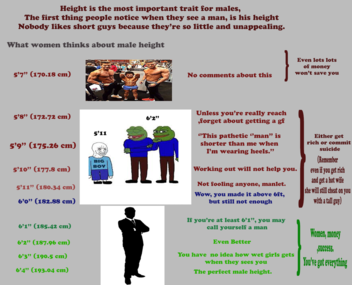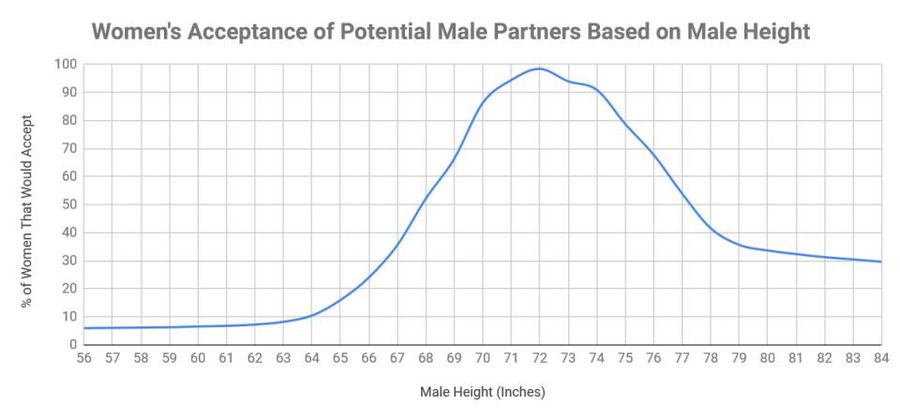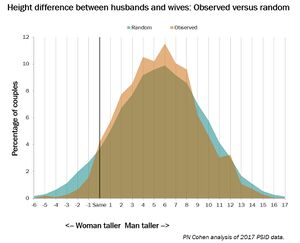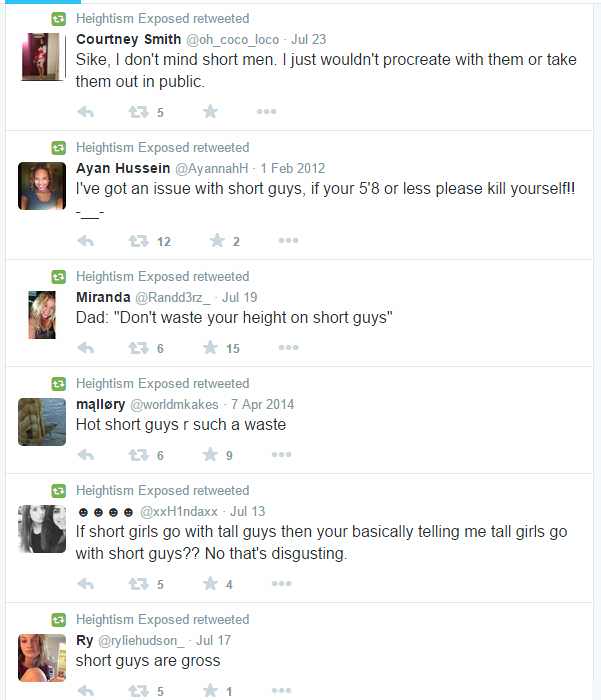Heightpill
The heightpill refers to the observation that many females tend to prefer men who are significantly taller than the average height. According to this perspective, a man’s height serves as a critical factor in determining his attractiveness. Additionally, proponents of the heightpill argue that some women experience a strong negative reaction (often described as “visceral disgust”) toward manlets.
It is important to note that as several studies show that this preference generally only modestly translate to actual pairings though (when not considering quality), so some argue the heightpill is generally exaggerated.
Someone who is an incel due to their height is known as a heightcel.
Intro[edit | edit source]
Originating from the biological needs of femoids, it concludes that manlets (men who rank in the bottom half in terms of height) are heavily disadvantaged in dating unless they have a Chad face or high status. This is because women are sexual gatekeepers and their near universal natural preference for tall men means that dating down in height is nearly impossible for women in a society that encourages natural female sexuality. Some conclude that for the depraved female species, the manlet cutoff might as well be under 6 foot even, thanks to hypergamy.
Suicide risk[edit | edit source]
See also: Just-world fallacy
Among manlets, the rate of experiencing ostracization and marginalization through out life is higher and overlooked or even laughed at by society, arising the suicide rate among shorter men drastically.[1][2]
Evolutionary origins of female height preference[edit | edit source]
Social constructionists like to explain heightism by norms, namely by the male taller norm. However, an evolutionary explanation would be that the taller male will on average be stronger and better able to ward off physical threats (bodyguard hypothesis).[3]
However, women seem to also generally adhere to a male-not-too-tall norm.[4] This is possibly due to egalitarian ideals, female fear of male violence, assortative mating for height and balancing selection for height (too tall offspring may be maladaptive), or perhaps just due to an aversion towards unusual pairings.
Other evolutionary psychologists explain the general female preference for taller height as stemming from a general (perhaps weak) preference for 'good genes' in a male partner to improve the viability of offspring. Evidence for this hypothesis is mixed, though some do conclude that taller stature is a broad indicator of healthy male development.[5]
Height is also weakly associated with general intelligence, and on the genetic level, suggesting that both are weakly correlated as part of an overall 'good genes factor' that has been (weakly) sexually selected for throughout human history.[6]
Tallfaggot advantage in online dating[edit | edit source]
Male height seems to be of high importance to women in online dating.
Stating your height in an online dating profile could fuck you over badly if you’re a manlet. According to a particular dating app, AYI (Are You Interested), 6'2"-6'8" (188-203 cm) was the ideal height range for males in terms of female first message rates.[7]
Specifically, they said:
A man who is 6’2″ is 17% more likely to be contacted than a man of average height of 5’8″ (173 cm) and 57% more likely to be contacted than a man under 5’5” (165 cm).
As men tend to exaggerate their height and reported heights on online dating are self-report, this may inflate the ideal height range a little as women seem to often have issues judging male height precisely.
If you are under 6'0", you are exponentially less attractive than 6'0" men[edit | edit source]
In a speed dating study on humans published in Animal Behavior, it was shown that men who are between 5'0" (150cm) and 5'11" (180 cm) are anywhere from 3–10 times less attractive than 6'0" (183cm) height men, solely because of their height.[8]
Of the male participants in this study who reported their height (many did not), the average height was a bit over 5 foot 10 (179 cm). In this study, men that were 7.2cm/2.8 inches above the average height of the male sample (and thus were 185 cm tall/6 foot 1) were most likely to match with women (based on height alone), which was both because this height was both generally desirable to women and because the men at this height men were more likely to accept the 'yes' response from the women compared to even taller men, who were more selective.[9] Regarding raw desirability (amount of times women gave a 'yes' response), the most desirable men were 2 metres tall (nearly 6 foot 7). However, these men received fewer 'matches' as they tended to be highly choosy, which was in contrast to the general tendency for men in this study to be less picky overall than women in saying 'yes' to a potential partner. Furthermore, the benefit of being tall on male desirability flattened out a fair bit after a height of 185 cm (6 foot 1) but may be linear to an extent even up to very tall heights.[10]
There was small evidence of assortative mating in this study, as taller individuals tended to match other tall individuals, but this was tempered by a female preference for men much taller than themselves, which resulted in men of average height matching more with short women. In contrast, very short men were most unlikely to be matched.[11] The average female height in this sample was 165 cm (5 foot 5).
It is important to note that heights in this study were self-reported. Men typically exaggerate their height by nearly an inch (2 cm) when asked directly about it[12] and this tendency may be exaggerated in dating contexts.[13] Women also tend to lie about their heights when asked.[14] Thus, the height figures given above for both sexes in this study may be exaggerated by up to 2 inches (~5 cm).
This study indicates that, at least in short-term mating environments, men of even very tall heights are more attractive to women, and little assortative mating occurs due to a high female preference for tall men. As noted elsewhere in this article, in cross-sectional studies that examine couples, there is usually a fair degree of assortative mating for height, and taller men do not tend to have much more sexual partners on average compared to short men. Thus, differences in choosiness and perhaps mating effort between men of different heights, as well as extreme promiscuity being rare among men in general,[15] likely account for the weaker effects found for male height in studies that examine only self-reported partner counts. Social desirability bias may also play a role, with men typically exaggerating their partner counts when asked, and if very short men are more likely to be passed over by women, this tendency may be greater among them. Feingold (1982) did find that taller men tended to have more attractive girlfriends, indicating that tall men are more likely to be choosy in regards to a potential partner's looks and be able to have that choosiness be rewarded with a more attractive female partner, as this speed dating study also implied.[16] This pickiness may limit tall men's ability to capitalize on their height by being extremely promiscuous, but is likely indicative of their knowledge of their greater value in the mating market and their higher overall 'bargaining power' with women. It may also indicate that greater male height is associated with a slow life history strategy based around a greater attention to long-term mating, as the converse has been found with shorter men, with research indicating they are often higher in the dark triad traits linked to a more indiscriminate mating strategy.[17]
Dating and Asian height obsession[edit | edit source]
A marriage is more likely to be successful if the male partner is tall. Women just feel happier about it.
Several studies in Asia completely proved this hypothesis.[18][19] However, some East Asian countries seem to have a particular obsession with height, which has been linked to a higher regard for traditional gender roles.[20]
On the other hand, research has shown this is not likely to be the cause of this phenomenon, as women's height preferences in male partners were found to be unrelated to their view on gender roles in Taiwan. The study found that men's preferences were weakly related to their gender role-related views (with more traditional men having a stronger aversion towards being paired with taller women), while for women, their own demographic characteristics influenced their height preferences. So, at least in this sample, feminist women showed no greater tendency to date shorter men. These ideal preferences based on gender-role orientation were not reflected in marriage patterns based on relative height for partnered men, indicating that they generally have a limited ability to translate such preferences to mating outcomes.[21]
The study provided more evidence for the trade-offs people often make in dating in regards to their ideal preferences for generally desirable traits, as the older (and generally less desirable) women got, the more they were open to dating shorter men, and the poorer men got, the more open they were to dating taller women.
Greater female choosiness due to a relative shortage of females compared to males may also play a role in exaggerating female height preference in countries like China. East Asian's slower life-history strategy may also increase female choosiness for height.
Studies have found that insecurities regarding height are pronounced in China, and are greater than self-reported concern regarding weight and facial appearance.[22]
Studies concerning the effect of height on mating outcomes[edit | edit source]
Overview[edit | edit source]
Research into the effect of body height on men's mating frequency and partner counts generally suggest a small effect, in contrast to studies that focus on short-term mating (speed dating) and female ideal preferences. These outcomes suggest height is only one factor involved in determining overall men's mating success, and that there are potentially trade-offs involved here, as well as assortative mating effects and balancing selection-related concerns that restrict strong positive sexual selection operating on male height.
A large cross-cultural meta-analysis conducted on the effects of various sexually dimorphic traits on men's mating and reproductive success found weak, but significant effects for height on mating success and reproductive success. These simple Pearson's correlations based analyses may be attentuated a bit by factors such as measurement error, sample heterogeneity, restriction of range, and curvilinear effects for height (being very tall may be deleterious, for example).[23]
An older study also found that taller men tended to have better looking girlfriends. Height also affected men's ability to 'date up' in looks, with taller men dating women who were overall more attractive than themselves more often. This study didn't examine the female partner's heights, and it's possible that some of the effect may stem from height being potentially associated with greater overall physical attractiveness in women, like you see with female fashion models who are selected for greater height.[24] Thus, it is possible that this association may be attributable to assortative mating for height. However, an unrelated study did find a weak positive relationship between female height and their facial attractiveness, but the trend was not significant, suggesting that height does not affect men's perceptions of female's facial attractiveness to the degree that male height influences their perception of a man's facial attractiveness.[25]
Kleisner et al. (2021) found a positive linear relationship between allometric sexual shape dimorphism in male faces (i.e facial masculinity not controlling for height) and their facial attractiveness. This suggests that taller men are also perceived as having more attractive faces by women on average. This may be because the faces are more attractive or that height is salient enough female perceptions of male physical attractiveness that they weigh perceived height from 'headshots' fairly strongly.[25]
Some studies even find a trend of higher coital frequency in the lower height categories.[26][27] These studies obviously selected for men who were sexually active, with steady female partners, and with no sexual complaints. These studies seem to show that when short men do enter relationships, they aren't more likely to be dead-bedroomed by their female partners, and it may also provide evidence of a link between short stature in males and a higher sex drive (and perhaps mating effort). This higher mating effort would compensate for manlet's lower desirability a bit in studies that only consider self-reported partner count as an indice of the effects of male height on dating.
Specific studies[edit | edit source]
A 2013 study by Gert Stulp found that height preferences only translate modestly into actual pairings. The males in relationships were on average not much taller than random pairing would suggest (as men are obviously taller than women on average).[28]
A 2015 Dutch study [29] suggested that natural selection (rather than sexual selection, i.e. mate choice) has acted on the Dutch population, and helped drive the Dutch toward taller heights. Some more recent studies show that average height may actually be declining on a genomic level in some modern populations, indicating that it may not be being strongly selected for in terms of reproductive success.[citation needed]
| Category | Average partner count |
|---|---|
| very short (5'2"–5'4"; 157–164 cm; 1%) | 9.4 |
| short (5'5"–5'7"; 165–171 cm; 9%) | 11.0 |
| average (5'8"–5'10"; 172–178 cm; 33%) | 11.7 |
| tall (5'11"–6'1"; 179–186 cm; 40%) | 12.0 |
| very tall (6'2"–6'4"; 187–194 cm; 15%) | 12.1 |
| extremely tall (6'5"+; greater than 194 cm; 2%) | 12.3 |
Jenkins & Frederick[edit | edit source]
In 2015, Jenkins and Frederick published a study based on a large online survey (N = 60,058) that found a slight positive relationship between male's body height and self-reported sex partner counts. Some criticise this study due to the age of the sample, the date of the study, and the selection method (users of a mainstream media TV companies website in the United States), claiming this may not be representative of contemporary dating.[30] The main findings are reproduced on the right.
The influence of male height on male self-reported lifetime partner count in this sample was, however, modest. Even when comparing the shortest men to the tall men, the effect size was only small, at d = .22. The effect size was similar when comparing short men to the average height category, and while being 'tall' or 'very tall' increased men's lifetime sex partner counts, this effect was minuscule, though statistically significant. 'Tall' was defined as being 5' 11"-6' 1" for men, so in the optimal range in North America as discovered by Stulp et al. (2013). Men taller than this didn't report a lower number of sexual partners, despite evidence showing diminishing returns for male height past roughly the +1 SD level (6 feet in the US), which the authors attributed to very tall men potentially succeeding at intrasexual competition (intimidating other men).
To provide a frame of reference for these effect sizes, they can be compared to the effect for BMI in this study, which found being 'underweight' for men reduced men's lifetime sex partner count by an effect size of d = -0.39 compared to being of average weight. This was larger in magnitude than the effect of severe obesity (d = -0.30, the association with simple 'obesity' and partner count was weakly positive), which may provide some fuel for bloatmaxxing and gymcelling among skinny men.
Taller men were less likely to be single, which may indicate that short men had greater difficulties retaining partners, or it may be further evidence that short-men are more likely to be pursuing a fast life history strategy focused on short-term mating and unstable pair-bonds. On the other hand, short and very short men were less likely to report having a high number of sex partners (> 14), though this may be evidence that they are more often being rejected by women despite their (possible) higher mating effort. There were, however, no links between extra-pair sexual activity (cheating) and male height in this study.
Discussion[edit | edit source]
Incel manlets may resist partaking in studies like this as they fear revealing their lack of sexual success, even in anonymous contexts.
This potentially creates a selection bias: the short men who do respond to the study are more likely outliers who get an unusually higher amount of sex than the typical man of their height due to other factors in their favor. It is a common phenomenon in the social sciences that survey participants are often over-selected for the trait that is being measured (e.g. people who take tests on narcissism are generally more narcissistic on average).
Short stature is linked to various other factors that predict lower sexual success such as mental and physical disease and higher developmental instability. Hence, short men reporting a slightly lower sexual activity might not be only due to their height, but also other factors adversely affecting their sexual performance/capacity to attain parters. However, shorter male height is also potentially linked to factors that promote promiscuity (often with lower quality partners and less investment), such as a faster life history strategy.
It is possible that men obsess over height due to men's tendency to compete each other via asserting physical dominance.[31]
Women also seem to often shit test men on height, or otherwise resort to height-related slurs as insults, as they know men are often insecure about it, like with penis size.
Though it is not clear how strongly physical dominance is associated with lifetime mating success, effects are weak for status (overall status) and reproductive success.[32]
Heightmatching[edit | edit source]
The Bluepill argument against the heightpill is that the male-female height difference is platonic at 15cm[33] or 6in[34]. CoffeeMeetsBagel[35] reflects this sentiment as well.
The research affirms such suspicion. According to Atlantic (2009)[36] and PN Cohen's Research (2017)[37], the average distribution of height difference between couples should be 6 inches (15cm), and that observed height difference has less variance and more leftward shew than random sampling of males and females (it is rarer than random chance to find someone with a height difference of more than 10 inches (25cm), or that the female is taller than the male. This leads to the question of female entitlement and "size kinks" in contrast to assortative mating.
In regards to preference[38], females ideally want a man with a 10 inch (25cm) height difference, whilst a man 2 inch (5cm) height difference. The 6 inch (15cm) couple height difference manifests as assortative matching.
Also note that Pawlowski has an alternative definition of heightmatching: that males should be ideally ~1.09x the female height, so roughly matching for percentile.
Abbreviations[edit | edit source]
If you have this property in your body with these four letters, you are perceived as significantly more romantic by your bare presence, levitate above the crowds, and you do not have to settle for misery:
| t. | a. | l. | l. |
| Top | all | limerence | leverage |
| The | alpha | life | levitation |
| Thrive | around | lovely | ladies |
Your body needs these four letters!
Women tend to pronounce “tall” in a soft and romantic way.
- (Example – Peter Jones: 201 cm / 6ft 7in)
- Example 2: Julian Claßen (193 cm / 6ft 4in)
- Example 3: Anthony Robbins (201cm / 6ft 7in)
Other possibilities[edit | edit source]
- H.e.i.g.h.t.:
- High society
- elegance
- imperator
- genetic quality
- hoarder of women
- testosterone
Pedos are shorter[edit | edit source]
A small sample study[39] noted a significant difference in height between child-molesters and rapists, is of a height of 5' 9.5" (with 95% confidence). This effect was equivalent to the effect of maternal smoking on adult height.
A larger scale study[40] discovered that pedophilic sex offenders are a quarter inch shorter than regular sex offenders. This may imply that there may be developmental or genetic issues that reduce the height of child molesters/pedophiles, in line with the general relative neurological, physical and intellectual deficits of this group of offenders.[41][42][43] This reinforces the role of height as a marker of 'good genes' and healthy development, albeit a weak one.
However, this has not taken into account life history strategy, masculinity and other potential biofactors linked to pedophilic attraction/offending (see also "masculinized" digit ratio in study[44]).
Blackpills for manlets[edit | edit source]
A TV reportage shows the heightpill by interviewing scientists, as well as conducting an experiment, proving that below 5'3 (160 cm), it never began:
The twitter account[45] commonly showed how judgemental women are toward manlets, even being distrustful of their personality or intentions just because they’re vertically disadvantaged.
FHO’s don’t even see us as worthy of any respect.
References[edit | edit source]
- ↑ https://ajp.psychiatryonline.org/doi/pdf/10.1176/appi.ajp.162.7.1373
- ↑ https://bioethicstoday.org/blog/short-people-have-no-reason-to-live/
- ↑ https://www.psychologytoday.com/us/blog/fulfillment-any-age/201306/why-women-want-tall-men
- ↑ https://incels.wiki/w/Scientific_Blackpill#A_man.27s_height_determines_his_dating_pool._Over_94.25_of_women_reject_men_for_being_.22too_short.22
- ↑ https://royalsocietypublishing.org/doi/10.1098/rspb.2017.1372
- ↑ https://medicalxpress.com/news/2014-03-genetic-link-height-iq.html
- ↑ https://web.archive.org/web/20160604172140/http://www.firstmet.com/dating-blog/online-dating-size-matters-male-height/
- ↑ https://www.researchgate.net/publication/236670565_The_height_of_choosiness_Mutual_mate_choice_for_stature_results_in_suboptimal_pair_formation_for_both_sexes
- ↑ https://www.researchgate.net/publication/236670565_The_height_of_choosiness_Mutual_mate_choice_for_stature_results_in_suboptimal_pair_formation_for_both_sexes p. 5
- ↑ ibid p. 6, fig. 4b
- ↑ ibid p. 6
- ↑ https://onlinelibrary.wiley.com/doi/abs/10.1111/j.1467-789X.2007.00347.x
- ↑ https://coffeemeetsbagel.com/blog/dating-statistics/how-tall-are-you-really/
- ↑ ibid
- ↑ https://www.econlib.org/archives/2015/01/gss_sf.html
- ↑ https://journals.sagepub.com/doi/10.2466/pr0.1982.50.3.810
- ↑ https://www.theguardian.com/commentisfree/2023/mar/02/short-man-psychopath-study-napoleon-complex
- ↑ https://www.providr.com/tall-husbands-and-short-wives/
- ↑ https://www.worldofbuzz.com/short-women-who-date-tall-men-have-the-happiest-relationships-study-shows/
- ↑ https://yasmindelrosarioofficial.medium.com/height-matters-the-reason-why-asian-women-prefer-taller-men-238235e1535a
- ↑ https://www.sciencedirect.com/science/article/abs/pii/S1570677X20301970
- ↑ https://www.ncbi.nlm.nih.gov/pmc/articles/PMC5517501/
- ↑ https://www.biorxiv.org/content/10.1101/2020.03.06.980896v1.full.pdf
- ↑ https://journals.sagepub.com/doi/10.2466/pr0.1982.50.3.810
- ↑ 25.0 25.1 https://www.nature.com/articles/s41598-021-85402-3.pdf
- ↑ https://www.nature.com/articles/ijir201157
- ↑ https://pubmed.ncbi.nlm.nih.gov/24964363/
- ↑ https://journals.plos.org/plosone/article?id=10.1371/journal.pone.0054186
- ↑ http://rspb.royalsocietypublishing.org/content/282/1806/20150211
- ↑ https://journals.sagepub.com/doi/pdf/10.1177/1474704915604563
- ↑ short guys will lose more often
- ↑ https://pubmed.ncbi.nlm.nih.gov/27601650/
- ↑ https://fivethirtyeight.com/features/how-common-is-it-for-a-man-to-be-shorter-than-his-partner/
- ↑ https://familyinequality.wordpress.com/2019/11/06/man-woman-couple-height-updated/
- ↑ https://coffeemeetsbagel.com/blog/dating-statistics/how-tall-are-you-really/
- ↑ https://www.theatlantic.com/sexes/archive/2013/01/why-its-so-rare-for-a-wife-to-be-taller-than-her-husband/272585/
- ↑ https://familyinequality.wordpress.com/2019/11/06/man-woman-couple-height-updated/
- ↑ https://doi.org/10.1016/j.anbehav.2013.03.038
- ↑ https://www.ncbi.nlm.nih.gov/pubmed/17952597
- ↑ https://doi.org/10.1080/01639625.2016.1254986
- ↑ https://pubmed.ncbi.nlm.nih.gov/31122623/
- ↑ https://pubmed.ncbi.nlm.nih.gov/26058490/
- ↑ https://jamanetwork.com/journals/jamapsychiatry/fullarticle/482315
- ↑ https://www.nature.com/articles/s41398-018-0326-0
- ↑ https://mobile.twitter.com/heightismxposed
See also[edit | edit source]
- Just be tall
- Blackpill
- Chad
- Baldlet
- Dickpill
- Dogpill
- Reverse dogpill
- Racepill
- Incels.co thread: “F_ck genetic lottery: I am too short.”
- Mogging
- Elevator shoes





